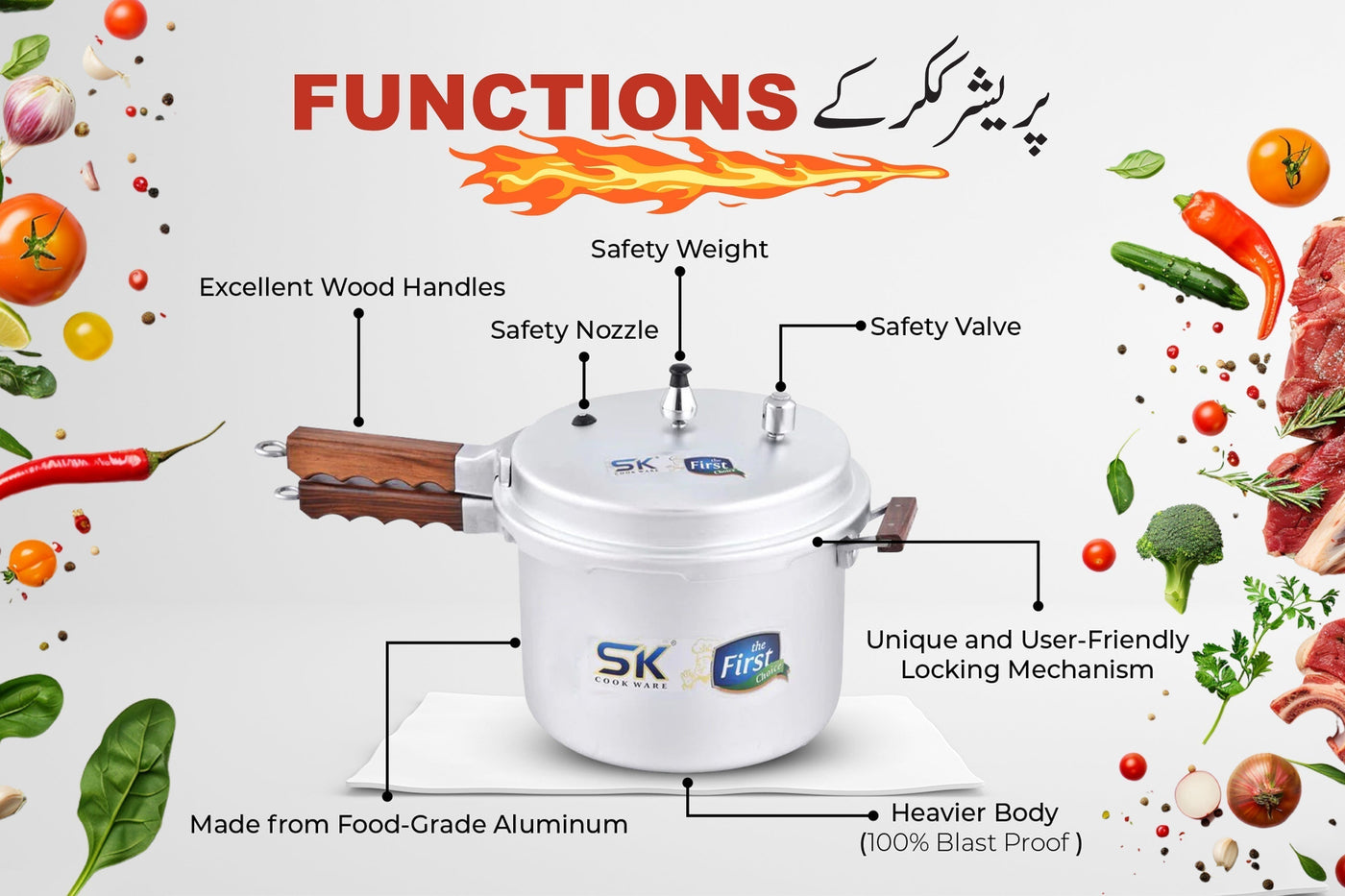What is the Function of a Pressure Cooker?
- Trapping Steam: When you add liquid (like water or broth) to the pressure cooker and heat it, the liquid turns into steam.
- Building Pressure: The sealed lid prevents the steam from escaping, causing pressure to build up inside the pot.
- Raising the Boiling Point: As pressure increases, the boiling point of water rises above the usual 100°C (212°F). This higher temperature allows food to cook faster.
-
Rapid Cooking: The combination of high pressure and high temperature significantly reduces cooking time, making the pressure cooker ideal for preparing meals in a fraction of the time compared to traditional methods.
Why is a Pressure Cooker Used for Rapid Cooking?
- Time-Saving: Dishes that typically take hours, like stews, beans, or tough cuts of meat, can be ready in under an hour.
- Energy Efficiency: Since cooking time is reduced, less energy is consumed compared to using an oven or stovetop for extended periods.
- Nutrient Retention: The shorter cooking time helps preserve vitamins and minerals that might otherwise be lost during prolonged cooking.
-
Tender Results: The high pressure breaks down tough fibers in meat and legumes, resulting in tender, flavorful dishes.
Common Uses of a Pressure Cooker
- Cooking Grains and Legumes: Rice, quinoa, lentils, and beans cook evenly and quickly.
- Tenderizing Meat: Tough cuts like brisket or pork shoulder become melt-in-your-mouth tender.
- Soups and Stews: Rich, flavorful broths and stews are ready in no time.
- Steaming Vegetables: Preserve nutrients and achieve perfect texture.
-
Desserts: Yes, you can even make cakes and puddings in a pressure cooker!
Pressure Cooker Repair at Home: Tips and Tricks
- Check the Sealing Ring: Over time, the rubber or silicone sealing ring can wear out or become misaligned. Inspect it regularly and replace it if it’s cracked or loose.
- Clean the Vent Pipe: A clogged vent pipe can prevent proper pressure buildup. Use a toothpick or small brush to clear any debris.
- Inspect the Safety Valve: Ensure the safety valve is functioning correctly. If it’s stuck or damaged, it may need to be replaced.
- Test the Lid Seal: If steam is escaping from the sides, the lid may not be sealing properly. Clean the rim and ensure the lid is locked in place.
-
Replace Worn-Out Parts: Many pressure cooker parts, like gaskets and valves, are replaceable. Check your user manual for guidance on ordering and installing new components.
گھر پر پریشر ککر کی مرمت: تجاویز اور ترکیبیں
کسی بھی کچن کے آلے کی طرح، پریشر ککر کو کبھی کبھار دیکھ بھال یا مرمت کی ضرورت پڑ سکتی ہے۔ اگرچہ کچھ مسائل کے لیے پیشہ ورانہ مدد درکار ہوتی ہے، لیکن بہت سے عام مسائل کو گھر پر ہی حل کیا جا سکتا ہے۔ گھر پر پریشر ککر کی مرمت کے لیے یہ کچھ تجاویز ہیں:
-
سیلنگ رنگ کی جانچ پڑتال: وقت کے ساتھ، ربڑ یا سلیکون کی سیلنگ رنگ خراب ہو سکتی ہے یا اپنی جگہ سے ہٹ سکتی ہے۔ اسے باقاعدگی سے چیک کریں اور اگر یہ پھٹی ہو یا ڈھیلی ہو تو اسے تبدیل کریں۔
-
وینٹ پائپ کو صاف کریں: اگر وینٹ پائپ بند ہو جائے تو صحیح دباؤ نہیں بن پاتا۔ کسی ٹوتھ پک یا چھوٹے برش سے کسی بھی گندگی کو صاف کریں۔
-
سیفٹی والو کی جانچ کریں: یقینی بنائیں کہ سیفٹی والو صحیح طریقے سے کام کر رہا ہے۔ اگر یہ پھنس گیا ہو یا خراب ہو تو اسے تبدیل کرنے کی ضرورت ہو سکتی ہے۔
-
ڈھکنا کی سیل کی جانچ کریں: اگر ڈھکن کے اطراف سے بھاپ نکل رہی ہو، تو ڈھکن صحیح طریقے سے بند نہیں ہو رہا۔ کنارے کو صاف کریں اور یقینی بنائیں کہ ڈھکن صحیح طریقے سے بند ہے۔
-
خراب ہونے والے پرزے تبدیل کریں: پریشر ککر کے بہت سے پرزے، جیسے گاسکیٹس اور والوز، تبدیل کیے جا سکتے ہیں۔ نئے پرزے خریدنے اور انسٹال کرنے کے لیے اپنی یوزر مینوئل چیک کریں۔
باقاعدہ دیکھ بھال آپ کے پریشر ککر کی زندگی کو بڑھا سکتی ہے اور اسے بہترین حالت میں رکھ سکتی ہے۔








